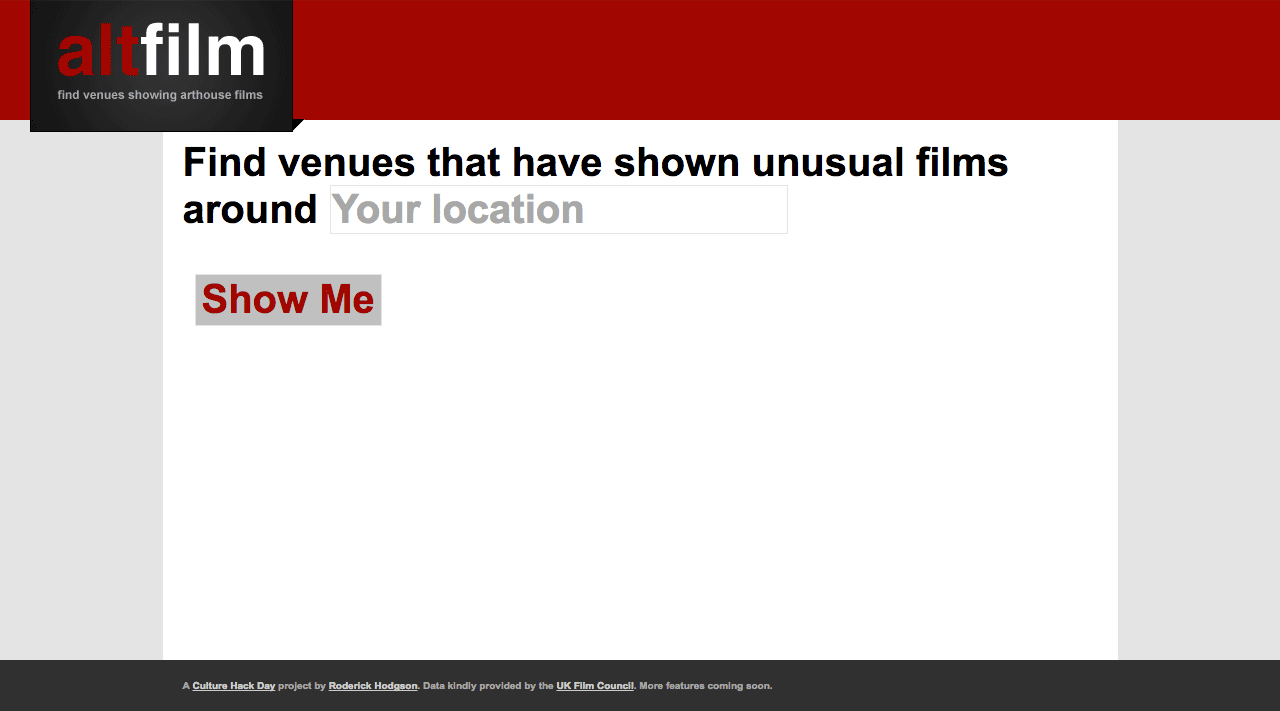AltFilm was a project I worked on at the 2011 Culture Hackday held in the Lost Boys International offices. The aim of the hack was for me to provide a tool for independent and world cinema buffs to discover venues around them that screen films, so they can experience watching films in unique venues.
Birth of an idea
I first arrived at the Culture Hackday without an idea of what to work on. Speaking to the British Film Institute (BFI), I found out they had a database of every venue that has ever shown a film in the UK, as provided by the UK Film Council (UKFC). Although a significant number of these were regular cinemas, I also noticed a wide range of community centres, pubs, cafes, libraries, culture spaces and many more.
I thought it was a shame that I did not know about these spaces around me, and set about finding a solution: building a website that would present users with a list of venues near them which are known to show films.
Capturing and presenting data
With the UKFC’s data in hand, I had to find a way to suggest venues near a user’s location. There were three steps to doing this:
- Determine the latitude and longitude of each venue.
- Determine the latitude and longitude of the user.
- Sort the venues by proximity and return a list of the top N venues.
Geolocation of a venue
The the UKFC’s data did not contain any geolocation information. It did contain postcodes (sometimes). I iterated over every venue in the data set, and queried the Google geolocation APIs for a latitude and longitude (using the postcode - if available, or the name of the venue if not).
With the geolocation information obtained, I saved every venue in the database, with latitude and longitude information saved alongside its name and address.
Determining the geolocation of a user
Determining the latitude and longitude of a user was very easy in 2011. It had recently been possible to query the user’s browser to find out their location. I was able to write a javascript snippet to request this information. Should they decline, should the browser not support this query, or should they wish to query a different location, I also designed a small input box to allow visitors to enter a location manually.
With the location information roughly gathered, this information was passed to the Google Maps API through an AJAX request. The latitude and longitude of the location, as well as a human-readable version of the location was retrieved asynchronously.
Once the results from my API obtained, the human-readable version of the location replaced the information in the input box. This allowed the user to verify their location information was correctly understood. At the same time, a query to my suggestion API was made. The outcome of that query — a JSON list of venues near that user, resulted in a list presented to the user. They were then free to change the input query whenever they wished, repeating the process.
Sorting the venues by location
With the user interface complete, I got to work on my suggestion API. I developed a RESTful API using Django.
Note: in 2011, this seemed like a reasonable choice. Now I would most likely use Flask-RESTful or Node.js+Express for a RESTful API.
The API would take in a latitude and longitude input, and return a list of nearby venues, with their address.
To do this, my Django-powered API queried the database and retrieved all newly stored locations from the database. I modified the venues Model in Django so it had an extra field “distance”, which returned the euclidean distance based on an input latitude and longitude. I then let Django sort the objects by this field. This approach, although quite neat and very Django-friendly was of course, completely crazy. It required all venues to be loaded in memory and a euclidean calculation to be performed thousands of time over. If I were to do this again, I would use a database which allows geolocation-based querying. This would allow scaling well beyond the number of venues I tried it with.
With the API returning a list of venues, I was ready to plug the three parts together. Returning a list of nearby venues to the user’s query.
Conclusion
This was really quite a simple hack. A front-end to a database. The most interesting part for me was sorting records in Django by distance, using latitude and longitude. However, it would be much more effective to use a database that supports that query mechanism directly, as it avoids having to load the entire database in a Python object. With many more results, a sharded database could work much more effectively.
Perhaps a project for another time soon!

